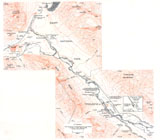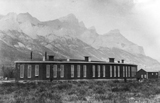Canmore-Banff Corridor Spur Lines
Bankhead
The CPR through its subsidiary Pacific Coal Mines obtained coal leases north-east of Banff that it began to exploit in 1903. A spur line and station were built.1 The coal, which deteriorated badly on exposure to the air, had to be mixed with pitch and made into briquettes in order to be of use for domestic consumption. For use in locomotives it had to be mixed with softer varieties of coal.2 Difficulties in extracting the coal from faulted and twisted seams, poor market conditions and intermittent labour strife led to the closure of the mine in 1922, though the briquetting plant remained in operation for a further eighteen months.3
Anthracite
Anthracite was established by the Canadian Anthracite Coal Company in 1886 with the property being leased to the W.H. McNeill Company in 1891.4 There were problems with flooding,5 the difficulty of extraction and quality of coal, much of which was unmarketable,6 and setbacks such as the flood of 18977 and the Canadian Pacific Railway’s preferance for cheaper coal from sources.8 The mine was finally closed in 1904 and Anthracite became a ghost town.
Georgetown
In 1910 William McCardell began prospecting on what was Kananaskis Coal Company property, but no development occurred.9 In 1913 the Canmore Navigation Coal Company (renamed Georgetown Collieries in 1914) commenced work on the site.10 The short spur that had served the Canada North-West Coal and Lumber Syndicate mine was extended to Georgetown.11 Most of the coal was destined for the steamship bunker trade. Financial difficulties in 1916 put the company into receivership and the colliery was closed with the property being acquired by the Canadian Anthracite Coal Company.12
Canmore
Canmore was established as a division point by the CPR in 1883.13 A roundhouse and ancillary services were provided, and a new station built in 1884.14 These became the nucleus of a new town. However, the change from wood to coal as fuel for locomotives, and technological changes in locomotive design allowing greater distances to be covered between service points rendered Canmore redundant as a division point, with services being centred in Calgary.15 Thus the future of the town depended on mining.
Just across the Bow River from Canmore (Townside) the Canada North-West Coal and Lumber Syndicate began mining on the site of an earlier claim variously known as the Brinkerhoff or the Cochrane.16 The mine tipple was served by a short spur off the line to Mine Number 1. Construction of a coking plant led to financial difficulties and the operation closed down. The mine was acquired by H.W. McNeill.17
The Anthracite Coal Company had also acquired properties at “Mineside,” and these as with its claims at Anthracite, were leased to the H.W. McNeill Company in 1891, which also opened Mine Number 1.18 According to historian A.A. den Otter, the CPR, assured of a supply of good quality coal at a reasonable price, provided a loan to McNeill for the development of the mine, a bonus for the coal, and built a spur line.19 The coal was used by the railway company between Medicine Hat and North Bend, B.C.20
With Mine Number 1 being worked-out (though it was not closed until 1916) a new mine (number 2) was established in 1908 and the railway spur extended.21 The McNeill interests, now the Canmore Coal Company, continued to lease the claims from the Anthracite Coal Company, the two companies amalgamating in 1938 to form Canmore Mines Limited which operated until 1976.22 From 1893 to 1976, 15, 573.9 K tonnes of coal were extracted.23 The mines continued to be dependent on the CPR for the purchase of most of the coal and for its transport until deiselization occurred. Further development by Canmore Mines necessitated the construction of a narrow gauge (29") electric railway to transport coal to the preparation plant at Mine number 2.24 Under a new corporation mining continued until 1979.
Notes | Bibliography | Abbreviations
1. W.F. Lothian, A History of Canada’s National Parks (Ottawa: Parks Canada, Indian and Northern Affairs, 1976), p. 96.2. Ibid., p. 98.
3. Ibid.
4. P. Lewis, “Resource Development in the Canmore Area” Alberta History 32.2 (Spring, 1984): 13.
5. B. Gadd, Bankhead: The Twenty Year Town (Calgary: The Coal Association of Canada, 1989), p. 15.
6. Lewis, p. 13.
7. Ibid., p. 14.
8. A.A. den Otter, “Bondage of Steam: The CPR and Western Canadian Coal,” in The CPR West: The Iron Road and the Making of a Nation, Dempsey, H., ed., (Vancouver: Douglas and McIntyre, 1984), p. 194.
9. PAA, 77.237/231a-c, Letter from J. Stirling, Provincial Inspector of Mines, 23 June 1910.
10. PAA, 77.237/231a-c, Letters from CNC to Stirling, May 1913; February 1914.
11. Department of Public Works, Annual Report, 1913.
12. J.D.R. Holmes, “The Canmore Corridor: The Historical Geography of a Pass Site, 1880 to the Present” (Thesis, Dept. of Geography, University of Calgary, 1978), p. 62; PAA, 77.237/231 a-c, October 27, 1916.
13. Lewis, p. 9.
14. Holmes, pp. 35, 37.
15. Ibid., p. 39.
16. Coal Mine Atlas, ERCB, p. T30; Coal Mines of the Canadian Anthracite Coal Company, p. 31; Letter from R. McKellar, Centennial Museum, Canmore.
17. Holmes, p. 50.
18. G. Tough, “A Study of Coal Mining: Cascade Coal Area” (Thesis, Dept. of Geography, University of Calgary, 1968), p. 45.
19. den Otter, “Bondage of Steam,” p. 194.
20. Tough, p. 46.
21. Holmes, p. 60. Info from E. Appleby. Canmore History of an Era (Calgary: E. Appleby, 1975).
22. Tough, p. 130.
23. Coal Mine Atlas, ERCB, p. T30.
24. Tough, p. 160.

